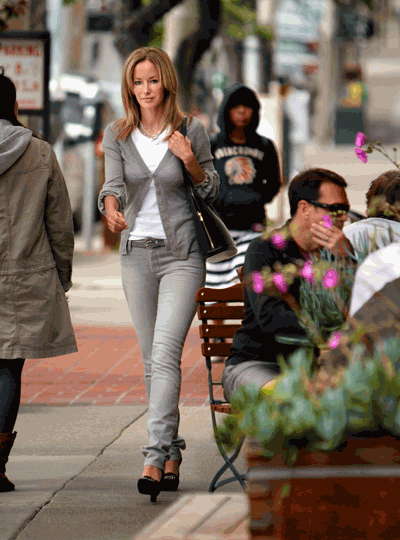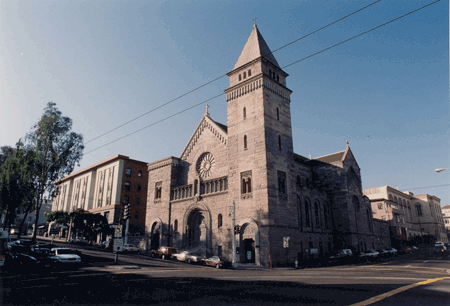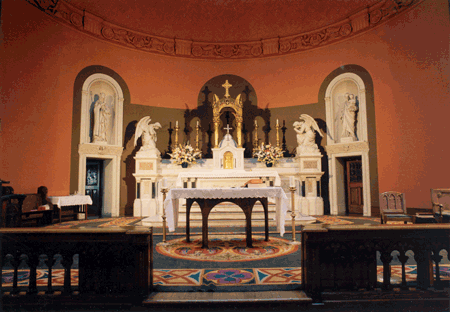
Photograph of Julian Guthrie on Fillmore Street by Chris Hardy
FIRST PERSON | JULIAN GUTHRIE
Having lived in San Francisco for nearly 20 years and worked as a reporter first for the Examiner and now for the Chronicle, I have come to see the different ways neighborhoods in the city are defined. For many, the center of a neighborhood is a coffee house, or a park, or a commercial strip to stroll. For me, it’s all those things.
 The area around Fillmore Street has long been my home. I jog the steps of Alta Plaza and spend countless hours at the playground with my son. We love the yogurt at Fraiche, the pastries at the Boulangerie and the Fillmore Bakeshop — and we adored its predecessor, Patisserie Delanghe. We’re regulars at Delfina and Dino’s and Florio and SPQR.
The area around Fillmore Street has long been my home. I jog the steps of Alta Plaza and spend countless hours at the playground with my son. We love the yogurt at Fraiche, the pastries at the Boulangerie and the Fillmore Bakeshop — and we adored its predecessor, Patisserie Delanghe. We’re regulars at Delfina and Dino’s and Florio and SPQR.
This neighborhood works, with its mix of young and old and in between, its families and dogs, its parks and shops. And while countless amazing stores and restaurants have come and gone (Fillamento, the Brown Bag and Bittersweet, to name a few), the relaxed character of the neighborhood remains the same. It’s what drew me here, and what keeps me here.
In recent years, I’ve learned of yet another way people define their neighborhoods: by a house of worship. My new book, The Grace of Everyday Saints — published August 18 — is about a group of people who found a strong sense of community through their spiritual home, St. Brigid, the muscular stone church at the corner of Broadway and Van Ness Avenue.
The parish, established in 1863, has always drawn people from Russian Hill, Nob Hill, the Marina and Pacific Heights. The Catholics of St. Brigid marked certain indelible moments of their lives there: baptisms, confirmations, confessions, weddings and funerals. They found comfort in the routine of sitting in those solid oak pews for Sunday Mass. Many told me they had moved into the neighborhood because of St. Brigid. Some had come from across the globe — from Mexico, Burma, the Philippines, Ireland, Italy — and settled into this corner of San Francisco, attaching themselves to the neighborhood because of the church.

St. Brigid Church at Broadway and Van Ness Avenue
Then, in late 1993, the San Francisco Archdiocese made an announcement that brought shock and sadness: St. Brigid, along with Sacred Heart on Fillmore and a dozen other Catholic churches across San Francisco, would close. There were fewer Catholics in the city. Fewer men were entering the priesthood. Buildings damaged by the 1989 Loma Prieta earthquake needed costly repairs.
St. Brigid parishioners reacted with anger, grief and — ultimately — resistance. The Grace of Everyday Saints, which began as a series of stories I wrote for the Chronicle, is about their struggle. I’ve spent nearly six years with this band from St. Brigid, struck by their devotion to this place they called home.
I also fell for the people — some great San Franciscans who embody the best of the city. There’s Robert Bryan, an appellate attorney who lives with his wife, Nicole, near the church in Pacific Heights. Bryan was just becoming a Catholic, but vowed to fight for the church as tenaciously as he would for a client on death row. There’s Father Cyril O’Sullivan, a young anti-establishment priest from Ireland who had to decide whether to follow the will of his superiors or the wish of his people. And there’s Joe Dignan, a reluctant Catholic who found answers to his inner turmoil at the same time he became a leader of the St. Brigid pack.
There are many other great characters: Carmen Esteva, a Filipina who moved a half-block from St. Brigid so she could attend Mass daily, believing it was the only way to save her soul. There is a humble housepainter, David Hansell, who took it upon himself to care for the church for years after it was closed, repairing the doors, removing graffiti, plucking weeds from its surroundings, treating it as a comatose loved one who would eventually awake. There is Siu-Mei Wong, who converted to Catholicism from Buddhism and forged a family from strangers.
And there is an image that still haunts: a solitary candle burning on the front steps of St. Brigid that its parishioners managed to keep aflame for 10 years as they took the battle from their sunlit sanctuary all the way to the steps of the Vatican in Rome. While these parishioners without a parish didn’t get everything they set out for, they found faith, joy and family redefined — and won unimagined victories along the way.

The altar at St. Brigid Church, which served the neighborhood for more than a century.
Filed under: Body & Soul, Books, First Person, Landmarks




